One of the most commonly used herbs in the kitchen and garden is the very versatile basil herb. Technically known as Ocimum basilicum, it can be a tad elusive for first-time growers looking at how to grow basil, requiring a decent understanding for a successful harvest.
However, once understood, it can be a fast and straightforward process. Here is your complete guide on how to grow basil at home, as well as care tips for growing basil in a pot.
More...
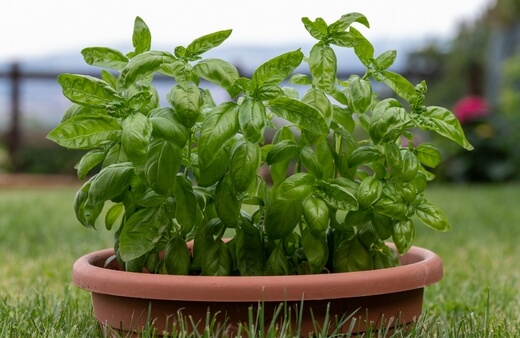
What is Basil?
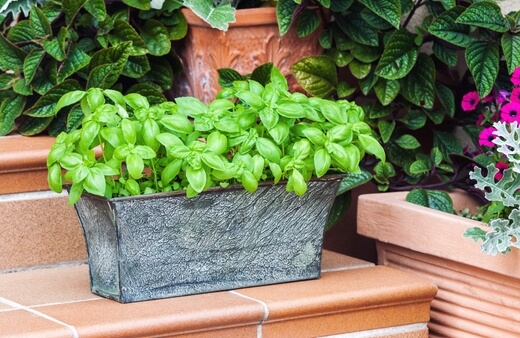
Basil is a fast-growing herb that originates from southern Asia and the islands of the South Pacific. The sweet-scented, aromatic flavours make the herb a popular addition to Italian and Mediterranean cuisine and many other modern dishes nowadays.
Whether you’re looking at growing basil in a pot or your garden, here is your complete guide on how to grow basil.
What are the Popular Types of Basil?
- Sweet Basil – This is the most common variety of basil widely used in pesto’s, salads, pasta and many more staple dishes worldwide. This will most likely be the variation you find at your local grocery store. It is usually a mild green in colour and cup-shaped.
- Thai Sweet Basil – Darker and smaller than sweet basil, Thai sweet basil offers hints of licorice profiles that keep even after cooking. This type of basil is popular in Asian dishes.
- Purple Basil – Used commonly in oils and kinds of vinegar. Purple basil presents pronounced purple hues and a more bitter flavour profile. It can also look gorgeous on a salad as accents to the garnish.
- Lemon Basil – Growing in popularity, lemon basil is an excellent alternative for your fish and poultry-based dishes.
- Spicy Globe Basil - Another cultivar of basil that grows as a compact, tidy bush with much smaller leaves. Offering a more peppery and sharp taste, spicy globe basil is also great as a garnish for fish dishes and salads.
- Cinnamon Basil – Wonderfully flavorful and spicy, cinnamon basil is a delightful alternative for grilled veggies, Asian dishes and fruit-based dishes.
How to Grow Basil

Basil can take as little as 4 to 6 weeks to harvest from seed. Therefore, basil is an excellent choice for beginner gardeners. Before we look at how to grow basil, here are a few factors to consider before propagation and planting:
- Be sure to wait at least 2 to 3 weeks after the last frost when your soil is between 10° to 21°C. You can also plant basil in Summer. Essentially the warmer, the better.
- Basil can be planted as an indoor plant in a pot or garden outdoors, as long as the conditions remain somewhat similar throughout the process. Basil requires primarily sun for about 6 to 8 hours per day.
- Basil can also be grown by root propagation. Cut a small section off an existing plant side-down. Place the cutting in a clear glass of water in a sunny location. Change the water every few days, and once you see the root has grown about 5 cm, the basil is primed for planting.
- If you intend on growing basil in a pot, be sure to try using a larger pot as the sun won’t dry the soil out as quickly, meaning you can water the basil less and reduce the risk of the ground being too dry for growth.
- Your soil should be rich in nutrients, moist and have a balanced pH level. How to grow basil successfully starts with optimal soil. You can add nutrients to your ground by using composts, mulches, or granular fertilisers.
- Should you intend on planting multiple basil plants, space them around 30 to 45 cm apart, making sure they each receive enough sun and wind.
- Be sure to check and water your basil regularly, especially in the hotter months.
Propagating, Germinating & Planting Basil
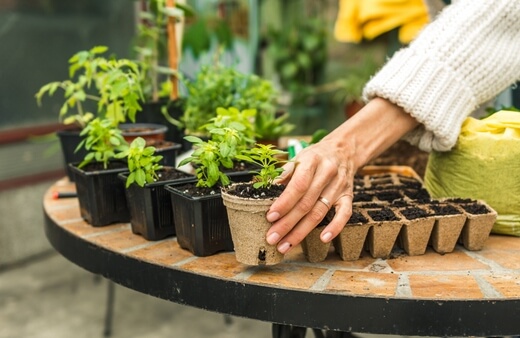
Put together your starting containers and add a slightly moist seed starter mix to about an inch from the top of your container. Doing this by hand is recommended for smaller containers.
Add a few seeds to the middle of your pot. Adding backup seeds is crucial as not every seed can germinate successfully. You can choose the best plant later in the process. Cover the seeds with your mix and preferably spray a light mist of water to moisten the soil gently.
Maintain your humidity by using specialised containers or a wide pot or pan with plastic wrap as a DIY alternative. How to grow basil fruitfully will be influenced by proper humidity control during these tender first steps.
Place your containers in a temperate location where the sun frequents often. You shouldn’t need to water again until the seeds have germinated. After around 7 to 10 days, you should be able to remove the plastic wrap and prepare to move the plant over to its pot or the garden. Be sure to keep the soil moist after removing the plastic.
Once proper leaves have started to develop, choose the best seedlings for your base and move them over to your pots using the same method you would if you were planting in your garden.
If you wish to grow basil in your garden, make sure the seedlings are ready by slowly introducing them to harsher conditions. Try placing them in pots first or placing them in sheltered places in your garden for periods during the day, then move them inside overnight.
Transferring Basil from a Pot into the Garden
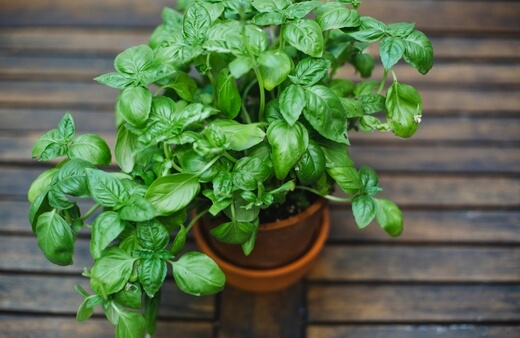
When temperatures reach a consistent 21°C, you can move your basil plant over to your herb, flower or vegetable garden. The location has to get a lot of sunlight. Basil thrives most with a good amount of warm morning sun and lighter shade during the midday heat peaks.
Your garden bed should be at least 20 cm deep, and the soil therein should be rich in organic nutrients and have good draining. Using mulches and other organic materials can help.
Dig a hole in your desired location and place the basil seedlings so that the root ball is level with the soil. Use your hands to gently cover the base slightly and adequately compact the ground with your fingers.
Water the basil plants and add about 2.5 to 5 cm of mulch to ensure moisture conservation and reduce competitor weeds.
Quick Care Tips for Planting Basil
It’s one thing to know how to grow basil, but it is also essential to understand how to care for and maintain the plants for longevity and regular harvests. Here are our top care tips:
- It may seem obvious, but regular watering is very important for basil. We recommend about 1.5 cm of water per week per plant. Basil in smaller containers or pots will need more frequent watering. Water your basil in the morning to prevent frost accumulation overnight
- Basil does not need a lot of fertiliser. Use only small amounts of light liquid fertiliser in your garden or your potted basil.
- Harvest regularly and pick at the leaves when full to encourage growth and a fuller, more bushy plant overall.
- Remove any flowers that might grow from the basil as soon as you notice them, as they will reduce the potency of the flavours your basil possesses.
How to Harvest Basil
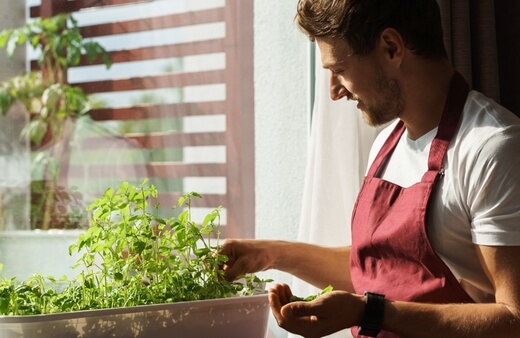
Basil is pretty straightforward in that you can pick at the leaves that are ready as and when you need them. Even if you don’t need them, regularly harvest your basil leaves to ensure a continuous growth stimulus.
You can store basil by freezing them in olive oil. Look at pruning your basil about every four weeks for the best flavour. Simply snip the stem above where the large leaves meet, rinse and enjoy!
Problems, Pests & Diseases
Fusarium Wilt – A common disease in sweet basil variants. Symptoms include stunted growth, yellowing leaves or browning spots on the leaves, twisted stems of irregular leaf dropping.
Unfortunately, there is no guaranteed way to deal with Fusarium Wilt. Destroy affected plants and avoid planting in that area for a couple of seasons.Mildew - If you notice your basil plants starting to develop a fuzzy, grey growth beneath the leaves, your plants could be suffering from Downy Mildew. To combat this, reduce your watering and try to improve air circulation for your affected plants.
Slugs, Aphids, and other Pests – Using insecticidal soaps and other well-known soapy home remedies can help with these common pests. Spray affected plants regularly to help with pest control. (Check out our in-depth guide on how to get rid of aphids for more info.)
Other common risks include root rot or mineral deficiencies.
How to Grow Basil - In Summary
- Basil plants are easy enough to grow and can be harvested regularly.
- They are adaptable for both indoor and outdoor environments.
- A variety of basil plants can each add their respective flavour profiles and benefits to your dishes.
- Conditions to grow basil are primarily flexible, and the plants themselves don’t require too much fuss and maintenance.
Whether you’re looking at how to grow basil in your garden or indoors, we hope you can go confidently into your grow and yield flavorful basil leaves soon. Be sure to get creative with your dishes and look for some fantastic, fresh recipes to compliment your crisp basil.
Published on February 25, 2023 by Maisie Blevins
Last Updated on January 29, 2024




